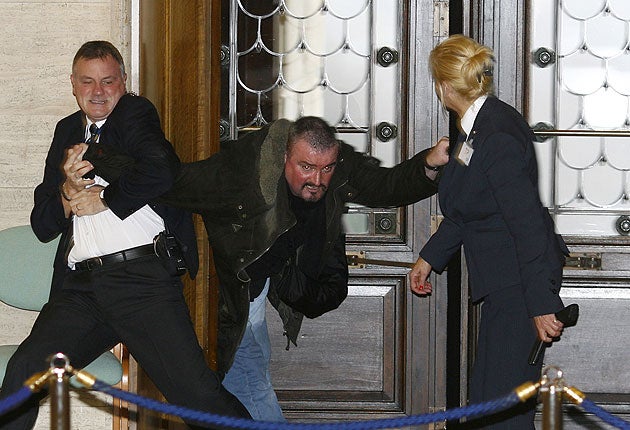Stone guilty of Stormont murder bid

Loyalist killer Michael Stone was found guilty today of attempting to murder Sinn Fein leaders Gerry Adams and Martin McGuinness in an armed attack on the Northern Ireland Parliament.
The 53-year-old former UDA member was convicted at Belfast Crown Court of the incident at Stormont in November 2006 when he stormed the building, while the Assembly was in session, armed with explosives and other weapons.
Stone, who gained notoriety in 1988 when he killed three mourners at an IRA funeral in West Belfast, claimed his actions at Stormont were all part of an elaborate performance art display.
Delivering his judgment in the non-jury trial, Mr Justice Deeney rejected this claim as being "wholly undeserved of belief".
TV cameras in situ to cover political developments in the stalling Northern Ireland peace process captured the moment Stone burst through the revolving doors and was hauled to the ground by two security guards - both of whom were later honoured for their bravery.
The judge said defence evidence that Stone had been taking part in some sort of a "comic parody" was "hopelessly unconvincing" and "self-contradictory".
"I am satisfied that Mr Stone went to Stormont to try and murder the two Sinn Fein leaders on November 24, 2006," he said.
After the verdict was read out, Stone, dressed in trademark denim jacket and jeans, shouted from the dock: "It is another concession to the Shinners (Sinn Fein)."
As well as the two attempted murder charges, he was convicted on seven other counts, including possession of nail bombs, three knives, a garrotte and an axe, as well as causing criminal damage to the Stormont building.
During the four-and-a-half-week trial defence lawyers had argued that these weapons were all "props", while letters Stone sent to two journalists outlining his intention to kill the senior republicans were also part of his "script".
The piece of interpretative theatre was designed to expose the hypocrisy of local politicians, the multiple killer had claimed.
But Crown prosecutors dismissed these theories as nonsense, accusing Stone of dreaming them up after the event in a bid to explain away murderous intentions.
The judge concurred with that assessment today and said the defence had failed to put any doubt in his mind that Stone had set out to kill the senior republicans.
He asked if it was supposed to be some form of act that had Stone admitted his desire to kill the men during police interview after his arrest.
"If this had really been a mere protest, that was the time to tell the police," he said.
The judge added that even if Stone was acting, that was no justification for criminal behaviour.
"It is clear to me that some action constituting performance art cannot justify the use of violence, the threat of violence or putting others at risk of violence," he said.
Mr Deeney said he was satisfied with the evidence of explosives experts that nail bombs and incendiary devices carried by Stone on his one-man mission were viable and could have caused death.
The event happened four months before the historic power-sharing deal between Sinn Fein and the Democratic Unionists on the day Ian Paisley and Martin McGuinness were due to be nominated as Northern Ireland's new First and Deputy First Ministers.
The trial, which was interrupted in June when Stone sacked some of his legal team, ended in late September with Mr Deeney taking the last six weeks to reach today's judgment.
Stone, who was released from prison on licence under the terms of the 1998 Good Friday Peace Agreement, will be sentenced next month.
Stone took two hours to walk from the gates of Stormont's parliament buildings to the front of the imposing Assembly.
He sprayed red paint on the pillars but was disturbed by one of the security guards and pointed the replica gun at him.
The man described zigzagging away from him in fear and raising the alarm.
The loyalist then attempted to force his way through the revolving doors but was trapped by security guard Sue Porter.
She wrestled the replica gun from him but he was able to light a fuse on one of the bags he was carrying and throw it into the hall.
He warned the woman that it would explode in five minutes.
Security guards thought he was a human bomb and the judge paid tribute to their courage.
After he was wrestled to the ground in front of the press, he told police he was a "dissident loyalist freelance".
Mr Justice Deeney said he told police: "I went to the parliament buildings today specifically to assassinate Gerry Adams and Martin McGuinness and to disrupt an event that was betraying us."
He branded the Sinn Fein leaders war criminals.
"I would have got in and stabbed Adams and McGuinness, cut their throats.
"I am not ashamed of where I went today. I was willing to give my life for my beliefs if I had to and take life, that is why I was there."
He changed his story in December 2006, when he blamed his actions on performance art and said the nails in the bombs were confetti.
Mr Deeney said: "This was not a symbol but the reality of something which had been designed over the troubles and was capable of causing serious injury and possibly death.
"The idea that there was some kind of symbol was therefore a wholly untenable one."
A military knife and two sharp fishermen's blades were among his arsenal.
Bookmark popover
Removed from bookmarks